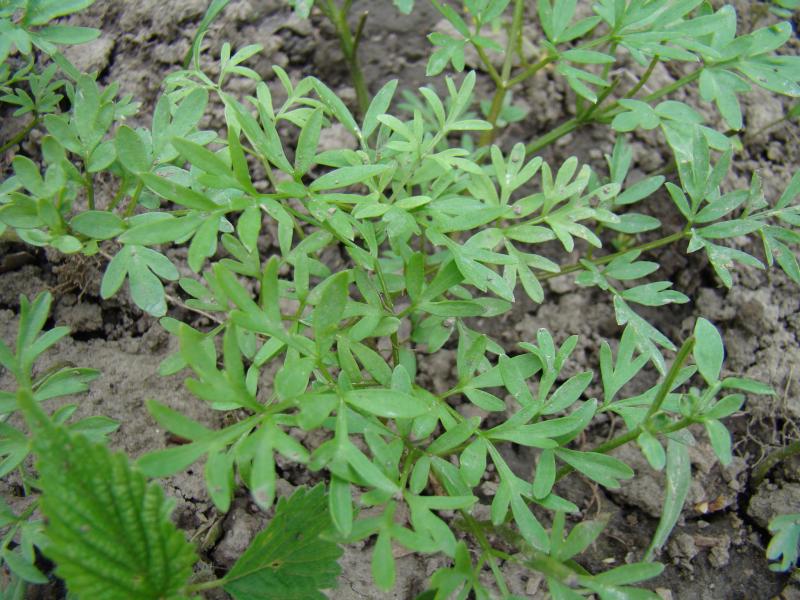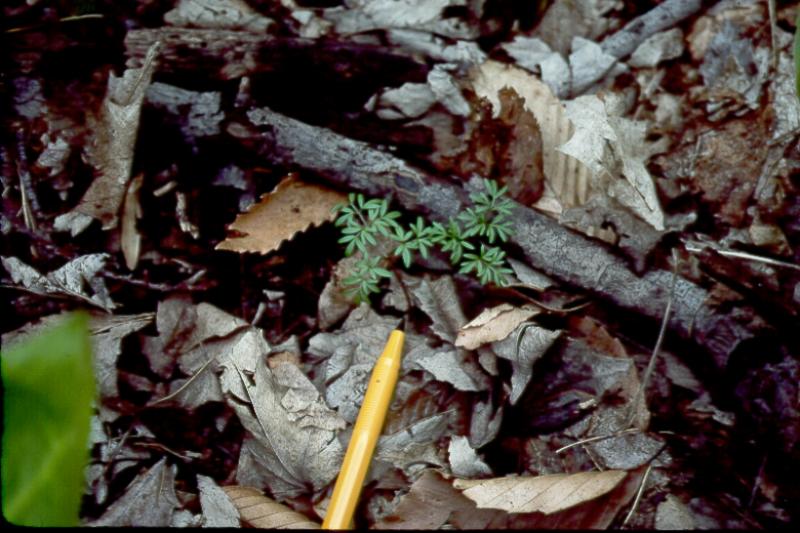Harbinger-of-spring
Erigenia bulbosa (Michx.) Nutt.
- Class
- Dicotyledoneae (Dicots)
- Family
- Apiaceae (Carrot Family)
- State Protection
- Endangered
Listed as Endangered by New York State: in imminent danger of extirpation in New York. For animals, taking, importation, transportation, or possession is prohibited, except under license or permit. For plants, removal or damage without the consent of the landowner is prohibited.
- Federal Protection
- Not Listed
- State Conservation Status Rank
- S1
Critically Imperiled in New York - Especially vulnerable to disappearing from New York due to extreme rarity or other factors; typically 5 or fewer populations or locations in New York, very few individuals, very restricted range, very few remaining acres (or miles of stream), and/or very steep declines.
- Global Conservation Status Rank
- G5
Secure globally - Common in the world; widespread and abundant (but may be rare in some parts of its range).
Summary
Did you know?
This was reported in New York for the first time way back in 1882 along Smoke Creek south of Buffalo where it has never been seen again. It has only been seen in New York a handful of times since then. The genus name is derived from the Greek for born in the spring and reflects its common name.
State Ranking Justification
There is one confirmed extant site with approximately 400 plants, two additional potentially extant sites lacking confirmation, and one historical site. The species has been confirmed as extirpated from three other sites.
Short-term Trends
The short term trend at the one extant site is stable but two additonal ocurrences could not be found during second surveys. This may indicate the that the overall short term trend is in decline.
Long-term Trends
This species has experienced a significant long term decline in the number of its populations. Currently only one of the original seven known populations is extant and vigorous.
Conservation and Management
Threats
Housing development in Buffalo area and development of the watershed surrounding the extant sites is a threat. Excessive deer browsing, the spread of invasive exotic species, and clearing of understory habitat around the plants are also threats.
Conservation Strategies and Management Practices
The forest understory where this species occurs should be left undisturbed. Monitor and control the spread of invasive exotic plant species within the forest stands were this species occurs.
Research Needs
Two populations need to be resurveyed to determine if they are extant or historical.
Habitat
Habitat
Harbinger-of-spring has been found in rich forests occuring at the base of a hillside in valley, in a low thinly wooded, bottom land, on a limestone hill. and in a mature spring ephermal rich bottomland hardwood forest (New York Natural Heritage 2015). Rich woods (Gleason and Cronquist 1991). Deciduous woods (Fernald 1950).
Associated Ecological Communities
- Floodplain forest
(guide)
A hardwood forest that occurs on mineral soils on low terraces of river floodplains and river deltas. These sites are characterized by their flood regime; low areas are annually flooded in spring, and high areas are flooded irregularly.
- Maple-basswood rich mesic forest
(guide)
A species rich hardwood forest that typically occurs on well-drained, moist soils of circumneutral pH. Rich herbs are predominant in the ground layer and are usually correlated with calcareous bedrock, although bedrock does not have to be exposed. The dominant trees are sugar maple, basswood, and white ash.
Associated Species
- Acer
- Acer saccharum (sugar maple)
- Alliaria petiolata (garlic mustard)
- Allium tricoccum
- Arisaema triphyllum
- Asarum canadense (wild ginger)
- Cardamine concatenata (cut-leaved toothwort)
- Carya
- Caulophyllum thalictroides (blue cohosh, late blue cohosh)
- Claytonia virginica (eastern spring-beauty)
- Clintonia borealis (blue bead-lily)
- Cornus amomum
- Dicentra cucullaria (Dutchman's breeches)
- Erythronium
- Fagus grandifolia (American beech)
- Floerkea proserpinacoides (false mermaid-weed)
- Fraxinus
- Hepatica nobilis
- Hydrophyllum virginianum
- Impatiens
- Lindernia
- Lonicera canadensis (American fly honeysuckle)
- Matteuccia struthiopteris
- Mertensia virginica (eastern bluebells)
- Onoclea sensibilis (sensitive fern)
- Rosa multiflora (multiflora rose)
- Rubus allegheniensis (common blackberry)
- Rumex
- Saxifraga pensylvanica
- Staphylea trifolia (bladdernut)
- Toxicodendron radicans
- Trillium
Range
New York State Distribution
Majority of occurrences are at the south end of Buffalo, 2 others in Monroe and Broome counties. New York is at the northeast edge of the range.
Global Distribution
Harbinger-of-spring occurs from southern Ontario, New York, southern Michigan and Wisconsin, west to Kansas and Oklahoma, south to Arkansas, Mississippi, Alabama and Georgia. This species hasn't been documented in South Carolina.
Identification Comments
Identifying Characteristics
Erigenia bulbosa is an erect, perennial forb, growing from 5 to 25 cm tall either singly or multi-stemmed from a rounded tuber root. The stems are smooth, fleshy, and purplish with a green base, the flowering stems are leafless. Leaves are one to few per plant, smooth and hairless (glabrous) broadly oval in outline with a rounded tip. They are repeatedly 3 parted (tenately compound) with stalks that clasp the stem, and the leaflet stalks (petiolules) are grooved on their upper surface. The flowers are 5-parted, with white petals and pink to wine-colored anthers that become black when dry. They are 63 to 86 mm wide borne in a 1.9 cm rounded, compound, terminal inflorescence (umbel) comprised of 1 to 4 stalked umbellets each with 1 to 6 stalkless flowers subtended by leafy bracts. The fruit are dry, somewhat flattened, and 2 to 3 mm long by 3 to 5 mm wide, splitting into 2 seeds.
Best Life Stage for Proper Identification
For positive identification a full stem with basal leaves and mature, intact flowers or fruits is best.
Similar Species
Three Dicentra species occur in New York and they may appear superficial similar to Erigenia when flowers are absent. Their leaves are also compound and basal but with linear lobes that are several times pinnately-divided and a relatively more slender appearing stalk (stipe). Dicentra flowers are borne in terminal clusters with flowers arranged singly along an elongated unbranched axis (raceme), are 4-parted with spurred petals have a more relatively slender stipe.
Best Time to See
Erigenia bulbosa typically flowers beginning in early April continuing through early to mid-May. Mature fruits are present beginning in early May and continuing through mid-June.
- Flowering
- Fruiting
The time of year you would expect to find Harbinger-of-spring flowering and fruiting in New York.
Harbinger-of-spring Images
Taxonomy
Harbinger-of-spring
Erigenia bulbosa (Michx.) Nutt.
- Kingdom Plantae
- Phylum Anthophyta
- Class Dicotyledoneae
(Dicots)
- Order Apiales
- Family Apiaceae (Carrot Family)
- Order Apiales
- Class Dicotyledoneae
(Dicots)
- Phylum Anthophyta
Additional Common Names
- Pepper-and-salt
Additional Resources
References
Fernald, M.L. 1970. Gray's Manual of Botany. 8th edition. D. Van Nostrand, New York. 1632 pp.
Gleason, Henry A. and A. Cronquist. 1991. Manual of Vascular Plants of Northeastern United States and Adjacent Canada. The New York Botanical Garden, Bronx, New York. 910 pp.
Holmgren, Noel. 1998. The Illustrated Companion to Gleason and Cronquist's Manual. Illustrations of the Vascular Plants of Northeastern United States and Adjacent Canada. The New York Botanical Garden, Bronx, New York.
New York Natural Heritage Program. 2024. New York Natural Heritage Program Databases. Albany, NY.
Weldy, T. and D. Werier. 2010. New York flora atlas. [S.M. Landry, K.N. Campbell, and L.D. Mabe (original application development), Florida Center for Community Design and Research http://www.fccdr.usf.edu/. University of South Florida http://www.usf.edu/]. New York Flora Association http://newyork.plantatlas.usf.edu/, Albany, New York
Links
About This Guide
Information for this guide was last updated on: January 8, 2016
Please cite this page as:
New York Natural Heritage Program. 2024.
Online Conservation Guide for
Erigenia bulbosa.
Available from: https://guides.nynhp.org/harbinger-of-spring/.
Accessed July 26, 2024.


